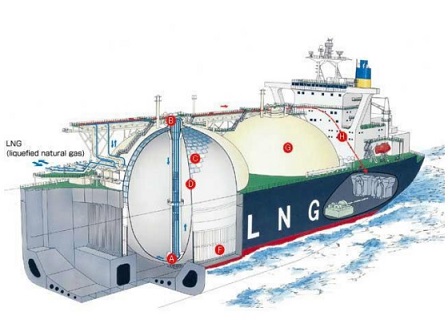Fig:LNG carrier underway
Under normal operational conditions primary and secondary barrier spaces are continually swept with nitrogen. A small leakage of methane vapour through the membrane may not be readily obvious. However, indications are likely to be:
- A sudden rise in the percentage of methane vapour in one primary insulation space. Some porosity in the primary barrier weld will allow the presence of methane vapour in the primary insulation space. The amount of this vapour should be kept to a minimum by nitrogen purging.
- If a porosity fracture occurs in the primary membrane barrier below the level of the liquid in the tank, the vapour concentration will increase slowly and steadily.
- If the fracture is above the liquid level, the concentration will exhibit a fluctuating increase.
- An increase in pressure due to vapour leakage will be less obvious than an increase due to liquid leakage. This is because the volume of vapour passing through a fracture is small compared with the volume of liquid, which subsequently vaporises, passing through the same fracture. In both cases, volumes are likely to be small in comparison with the volume of the inter barrier space.
- A fracture above the liquid level in a cargo tank will allow direct flow of vapour into the primary insulation space. This flow will vary according to the pressure in the tank.
- A porosity fracture in the primary membrane below the liquid level in a cargo tank, resulting in a small amount of liquid vaporising as it passes through the fracture, will cause a small increase in pressure. This increase is dependent upon the height of liquid above the fracture and the pressure in the tank.
- No temperature change will be obvious, unless the fracture is in the immediate vicinity of the sensors below the cargo tank.
- Leakage of methane vapour into the primary insulation space presents no immediate danger to the tank or vessel. As much as possible information concerning the fracture and leak should be obtained and recorded. Ascertain whether the risk is increasing, as follows:
- After the leak is detected, and without changing the flow of nitrogen to the primary insulation space, record the gas concentration and primary space temperature every hour for eight hours.
- Then, if necessary, adjust the flow of nitrogen to maintain the gas concentration below 30% (vol) and record the gas concentration and primary insulation space temperature every four hours.
- In conjunction with the above, record all pressure changes occurring in the cargo tank and primary insulation space. Where there has been an LNG vapour leakage to a primary insulation space, the nitrogen supply controller should be set to the appropriate pressure setting and the space purged.

LNG tanks configuration